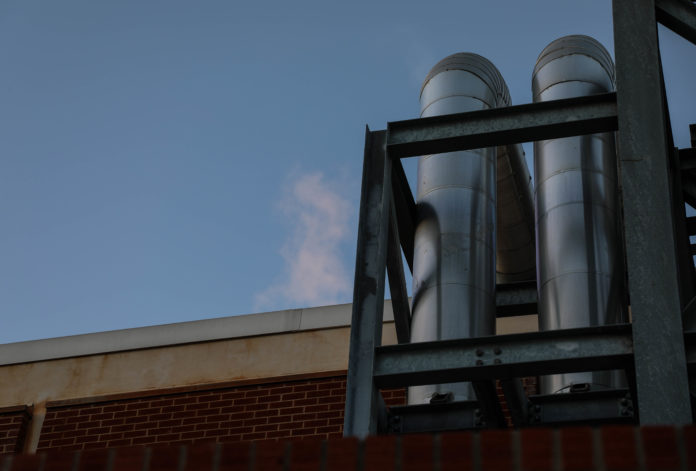
By Matthew Warden | Contributor
When walking between the Allbritton House and Moody Memorial Library, it can be common to see and feel a mist present in the air.
Rancho Palos Verdes, Calif., junior Olivia Azzopardi, like other Baylor students, is curious as to why she is rained on every time she “walks by that humming industrial building next to Moody.”
The water vapor, which has been confirmed to be clean and containing no toxins, is the byproduct of the Baylor Energy Complex (BEC), the central utility plant of Baylor’s main campus.
According to Michael Landolt, maintenance manager for the Baylor Energy Complex, the building is responsible “for producing and distributing steam and chilled water to all the buildings throughout campus.”
The steam and cooled water are transported via a system of pipes below Baylor’s campus and are used to provide heating and cooling for occupied spaces. They also produce hot water for everything from food production in the kitchens to showers in the residence halls.
“The Baylor Energy Complex produces its steam and cooled water via three boilers capable of producing 90,000 pounds of steam per hour and eight chillers capable of producing 15,700 refrigeration tons of cooling,” Landolt said.
Landolt said that’s roughly the weight of 72 fully loaded school buses per day in steam and the cooling power of about 386,000 household refrigerators. This production capacity makes the Baylor Energy Complex the single largest user of electricity and natural gas at the university.
Landolt said that having a centralized heating and cooling facility like the Baylor Energy Complex is appealing to Baylor because of its efficiency.
“The electricity needed to produce cooling for a space can be as much as 15-20% less for the Baylor Energy Complex’s equipment when compared to smaller residential air conditioning units,” Landolt said. “With steam production for heating and hot water, the boilers have advanced systems installed to ensure that the natural gas used in the boiling process is used as efficiently as possible.”
Landolt also said that the BEC appeals as a service to Baylor due to its reliability and cost savings.
“As for reliability, the BEC’s centralized production scale allows it to meet the demands, ensuring all of Baylor University’s buildings have the heating and cooling capacities needed at all times,” Landolt said. “Additionally, the centralization of equipment in one main plant reduces maintenance costs to Baylor by reducing the number of pieces of equipment needing to be maintained. This means lower utility costs for the university and lower tuition for its students.”
Aramark Facility Services manages most of the utilities on campus, including the Baylor Energy Complex. Landolt is one member of the team available around the clock to ensure that the facility runs efficiently and reliably.
To keep in the spirit of Aramark’s mission statement to maximize the student experience on campus and at the request of Baylor professors, the Baylor Energy Complex hosts presentations and tours of the facility for a number of classes at the university.
Dr. Elon Terrell, senior lecturer at Baylor’s Rogers School of Engineering and Computer Science, is one of the professors who uses the Baylor Energy Complex as a tool to teach his students about thermodynamics — the physics of heat and energy.
“After sitting through many lectures, [the students] enjoy being able to get their feet wet by seeing the real-world applications of what they are learning … especially when they see that the processes in the Baylor Energy Complex are something that affects them every day,” Terrell said.
When students walk by the Baylor Energy Complex and feel the familiar mist on their faces, Landolt said he hopes students know that the complex and its Aramark managing crew are working hard to provide Baylor’s students with the best environment possible for living and learning.
For more information on the Baylor Energy Complex and its role on campus, visit the Baylor website.





